After nearly a week on foot in Cefalu, we take the early
morning train back to the Palermo airport and pick up our rental car. Then, we set off for the northwestern corner
of the island to see our first set of Greek ruins. We plan to spend the night in the coastal
city of Trapani,
and stop first at the nearby hilltop medieval town of Erice to
find what the Lonely Planet says is Sicily’s best and most famous cake shop and
to see the narrow medieval streets and Norman fortress on top. We are forewarned by the book that the
mountaintop is often shrouded by “Venus’s veil” of mist on winter days, and we
are fortunate enough to get the full local experience as we can hardly see
anything. In fact, the narrow zigzagging
road is virtually impassable just as we get to the top as the fog becomes pea
soup and we creep slowly and thankfully into a parking space in the town square.
Phyllis worries a little bit about the
drive back down, but finding the Maria Grammatico
pasticceria and sitting down
for a pastry lunch helps calm her nerves.
We have the entire town to ourselves, likely because there are few
tourists in winter anyway and those around are likely too smart to come out in such
raw weather. At least it’s not pouring
rain, but it’s foggy and windy and cold.
We see one other group of sightseers who seem to be searching for Maria
Grammatico’s as well, but they give up too soon and disappear into one of the
few open cafes, never to be seen again. After
our pastry lunch we wander up and down mysterious foggy cobblestone streets (the
town is built on a hillside after all) and the iPhone GPS application is
stymied by the continuous stone walls that surround us (i.e. the old stone
buildings crammed along the narrow streets).
It’s eerie and magical, and frankly, it’s just fine with us this
way. We finally find the castle but it’s
closed (no surprise there) and barely visible in the fog. It must be a spectacular view from up here on
a clear day.
We wind our way back down the switchback road, very slowly
until we get below the fog level, and drive on into nearby Trapani. Our hotel is in the old medieval part of
town, and Phyllis’ nerves are tested again as we drive around in what seems
like circles on narrow
cobblestone streets until we find it. Again, the GPS is confused by all that stone
and only intermittently of help. And it
seems there is always some local driver in a hurry behind her. But it’s a beautiful old town center and a
great little boutique hotel. In fact
when we finally find it we are surprised to drive down an empty fairly wide
street and have no trouble parking right in front. This oddity is explained by the person at the
desk who speaks sufficient English to communicate
that the “street” we are now
parked on is a pedestrian mall. Oops. We then find a free lot only to be accosted
by several gentlemen who, for two Euro, will make sure nothing happens to our car
while it is parked there. We negotiate
for one Euro. Who are we to disregard long held local cultural traditions.
The very helpful front desk clerk loves practicing her
English and gives us good recommendations for an evening walk along the old
seawall, a visit to a church, and a locally renowned pizza place (“made the
Sicilian way”, she calls it). The
seawall extends
for almost a mile and gives us a good appetite. We also try the local beer with our pizza,
but miss the darker stouts and porters we’ve grown fond of the in the U.S. Apart from Todo Modo in Cefalu, dark beers
have been as hard to find in Italy as they were in Tanzania.
While waiting for the pizzeria to open we wandered into the
nearby church, Chiesa Del Purgotorio, just as it is getting ready to close for
the evening. What we find on the inside is
amazing; the church contains maybe 20 or so life sized wooden “scenes” from the crucifixion of Christ, set on what appear to be very heavy bases. Apparently at Easter large
numbers of stout
men lift these up, carry them out and parade them along the streets past
thousands of onlookers. The statues were, for the most part, originally created
during the 18th century but a few have been replaced over the years
due to, among other things, WWII bombing.
At least one statute references a repair made after it was dropped but
it seems most astonishing that this does not happen on an annual basis. We have time to look at most of them
carefully thanks to an indulgent priest.

 Trapani, Sicily, Italy
Trapani, Sicily, Italy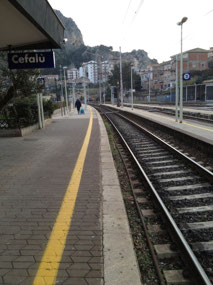
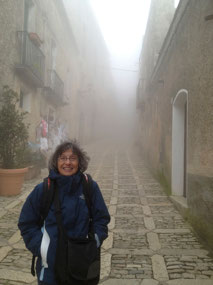
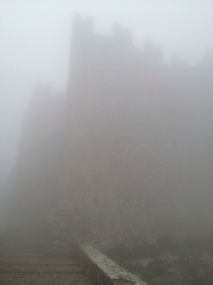
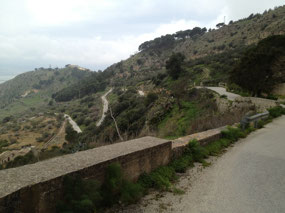
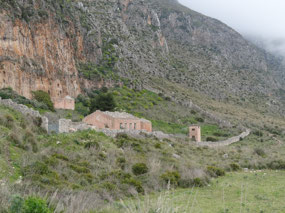
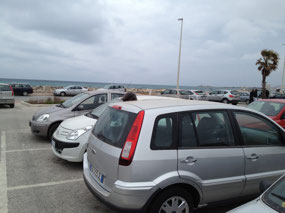





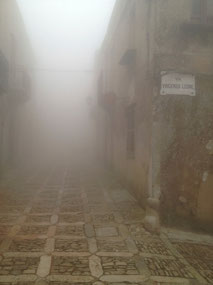
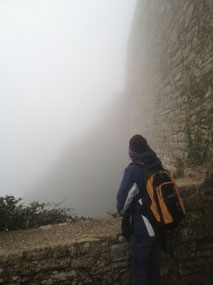
2025-05-23